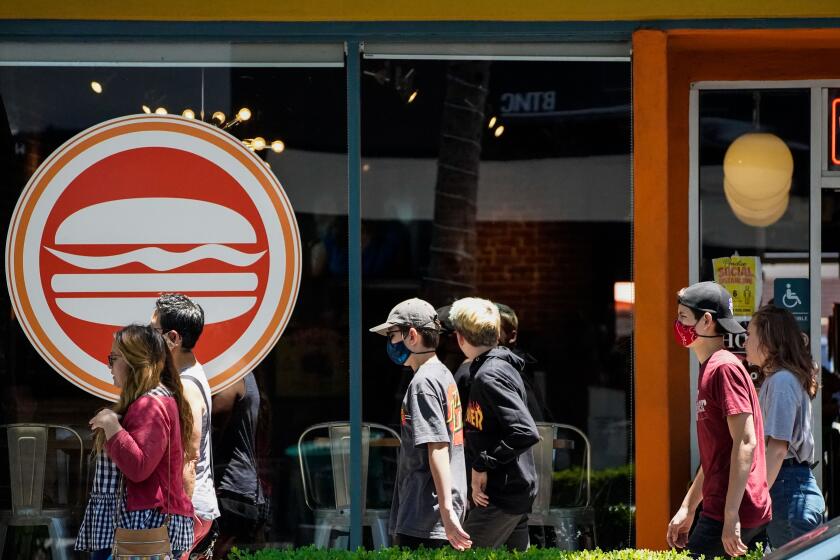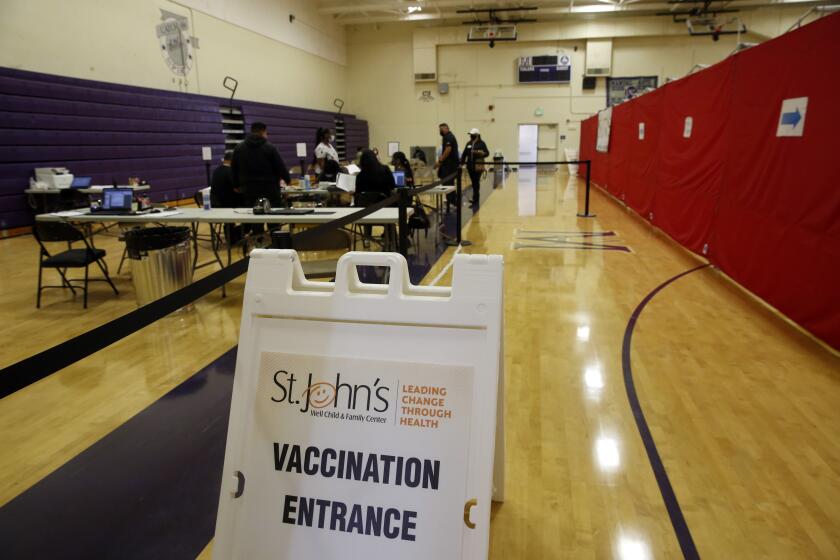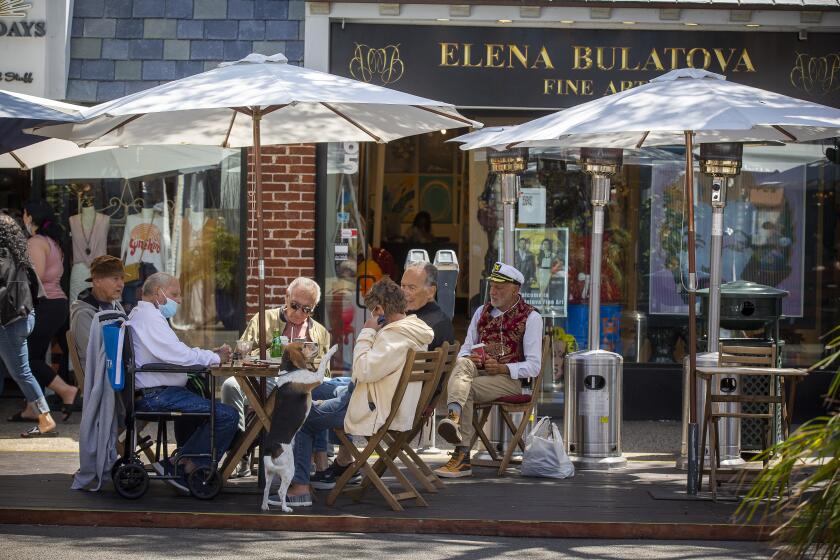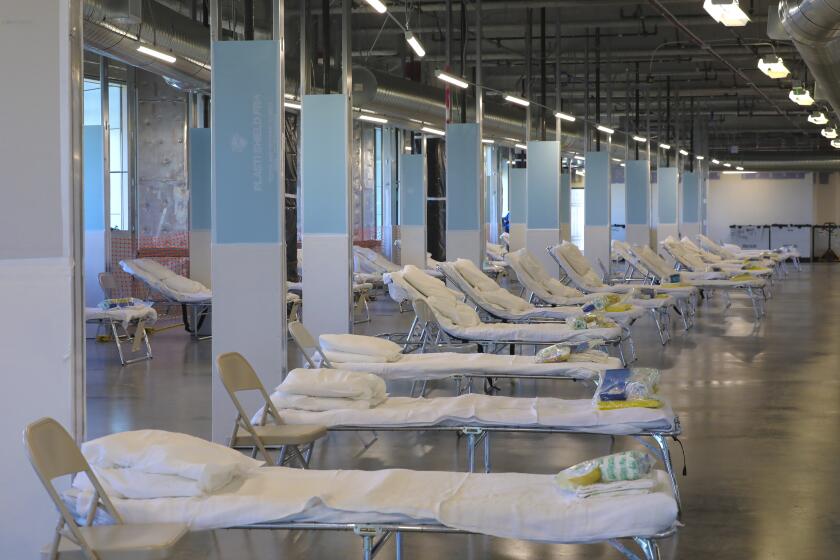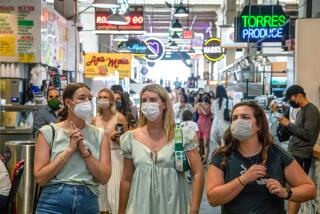Expired PPE, staff shortages, English-only outreach: Orange County’s troubled COVID response
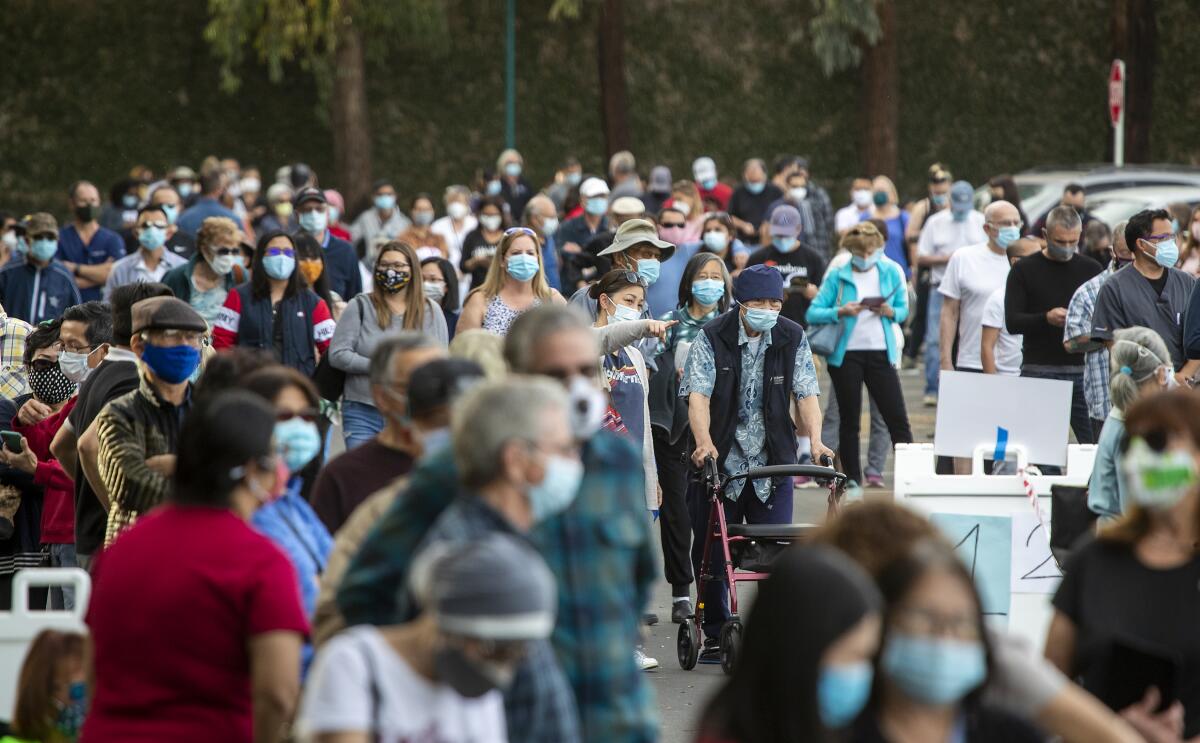
- Share via
In early 2020, as COVID-19 cases began popping up across Southern California, Rep. Michelle Steel’s message to her constituents brimmed with the optimism that Orange County might be able to avoid an outbreak.
“We will do whatever we can do [to] keep Orange County coronavirus-free,” Steel — then the chair of the county’s Board of Supervisors — said in late February. Less than a month later, the county identified its first COVID-19 infection from community spread. Over the course of 15 months, the virus would infect more than 254,000 people and kill over 5,000 in Orange County alone.
An investigation by the Orange County Grand Jury shows Steel wasn’t alone in thinking it was possible to stem the rising tide of a pandemic. A report released last week showed that county officials for years had largely underestimated the threat of a global pandemic — classifying it as likely as a disaster at the San Onofre nuclear plant or an act of terrorism. That mindset resulted in a response that stymied outreach efforts to hard-hit communities and hindered access to testing and vaccines, according to the report.
It’s an issue that bedeviled other jurisdictions across California and the U.S. as COVID-19 infections picked up steam and areas struggled with calibrating how hard they should respond. But Orange County stands out because of the distinct role some of its politicians and residents played in fighting back against tough restrictions meant to slow the spread of the coronavirus.
Orange County quickly became a nexus of COVID-19 doubt in 2020.
‘This does not diminish the importance of face coverings,’ Orange County’s new health director says in loosening COVID-19 pandemic requirements.
When Los Angeles County closed its beaches in an effort to enforce social-distancing guidelines, most Orange County beaches stayed open. When Democratic Gov. Gavin Newsom ordered the county’s shorelines closed in April after photos circulated showing throngs of beachgoers, it unleashed a torrent of criticism from conservative elected officials.
When Orange County imposed a mask order in June, mobs of protesters screamed at politicians during county meetings. Anti-vaccination crusader Leigh Dundas publicized the personal history and home address of the county health officer, Nichole Quick, during a Board of Supervisors meeting and then showed up at the doctor’s home with a banner depicting Quick as Adolf Hitler. She resigned within days.
Months later, when the state issued a mandatory 10 p.m. curfew to try to stave off more coronavirus infections, protesters calling themselves the “curfew breakers” converged near the Huntington Beach Pier in what they said was an attempt to take back their liberty from the liberals in Sacramento.
The county has 90 days to respond to the grand jury’s report. Board of Supervisors Chair Andrew Do called the report overly broad and said it didn’t take into account the conditions officials faced when the virus hit.
“To the degree that it comes across as a criticism, I take a little issue with that. Looking back a year later is more than just Monday-morning quarterbacking,” Do said. “It’s not enough to put into proper context what everybody knew happened, which was the world lost its mind at that moment because we had a thousand concerns.”
Two-thirds of adult Californians are now at least partially vaccinated for COVID-19 — a hopeful milestone on the way to widespread community protection.
Andrew Noymer, an epidemiologist and associate professor of public health at UC Irvine, said it’s not surprising the severity of COVID-19 took people by surprise. Pandemics that have occurred in the past 100 years, including the most recent H1N1 “swine flu” in 2009, paled in comparison with the Spanish flu in 1918 and COVID-19, which has killed more than 589,000 people in the United States and infected more than 33 million. In California, more than 3.7 million residents have been infected, and over 62,000 have died from the illness.
“The fact that the most recent pandemic was such a damp squib really left people unprepared [for COVID-19],” Noymer said. “It took a lot of air out of the balloon.”
After Newsom declared a state of emergency, Orange County remained hesitant to fully commit to restrictions handed down by the state. Despite pushback against such constraints, fewer people became infected and died in Orange County compared with Los Angeles County, which was an early adopter of COVID-19 regulations.
Bars, saunas and steam rooms can all reopen indoors, and other businesses can expand operations.
Compared with Orange County, L.A. is far more urbanized and has a larger population of essential workers, whose jobs made it impossible to work from home. More than 1.2 million people have been infected by COVID-19 in L.A. County, and more than 24,000 have died.
Still, the Orange County Grand Jury warned that if problems aren’t addressed locally now, future pandemics will pose significant challenges. Scientists have warned that other pandemics could be on the horizon.
Noymer agrees that the aftermath of COVID-19 is a prime opportunity for governments to do an accounting of what was successful as they rolled out their emergency plans and where they hit speed bumps. Orange County is the first in the region to take that step publicly.
When faced with mounting a response to the coronavirus in early 2020, Orange County officials were caught somewhat flat-footed, the report showed. They underestimated the requirements necessary to communicate with the public and lacked established relationships with community groups in hard-to-reach areas, an issue that challenged efforts to educate residents in hard-hit cities and hindered access to testing and, later, vaccines.
Additionally, the 19-member grand jury noted that some of the county’s stockpile of personal protective equipment was expired when the pandemic hit, and its durable medical equipment had not been maintained and needed substantial repair.
Furthermore, the Orange County Health Care Agency was understaffed. When faced with shortages, rather than hire more people, the county opted to borrow employees from other divisions and train them to help with COVID-19 — a situation the grand jury says led to execution problems and errors.
But Orange County wasn’t the only place in Southern California to struggle with adapting to the reality of the swift-spreading virus. A shortage of trained staff was a major hurdle for counties across the region, officials said.
In San Bernardino County, officials quickly learned the demands of the pandemic required more effort than their public health department could handle. They tapped other county departments, including the library and public defender’s office, to assist.
“Ordinarily when it comes to enforcing health orders, there’s a few people within the county that do that. When suddenly you have these sweeping state orders to close down businesses and launch a huge testing program, there’s no way the existing staff could do that,” county spokesman David Wert said.
Los Angeles County health staffers also have felt the strain of maintaining a large-scale response for more than a year. For months, staff didn’t take vacations, and some didn’t have days off. That’s continuing in some departments because the county has a limited number of people who have the level of expertise needed to manage such a massive response, L.A. County Public Health Director Barbara Ferrer said.
“If there’s one positive that may come out of this, I think it’s recognizing that public health departments need to be better staffed in the first place so that they are actually able to appropriately respond when these emergencies happen,” Ferrer said.
California has so far hired only one in 10 temporary medical professionals needed to help with surging caseloads during the pandemic.
The grand jury also admonished Orange County for its failure to quickly translate information about the deadly coronavirus, including testing resources, into languages other than English. While nearly half of the county’s 3.2 million residents speak a language other than English, information about testing sites wasn’t translated for most of 2020, according to the grand jury’s report.
“This limited Orange County Health Care Agency’s capability to effectively communicate with all residents, especially in the hot spots of Orange County, contributing to the spread of COVID-19,” the report said.
Supervisor Katrina Foley, who was mayor of Costa Mesa when the pandemic began, experienced firsthand a response from the county she said was just not helpful. It was challenging to get city-specific information, and it was clear the Health Care Agency didn’t have the funding and resources it needed, she said.
“I think there’s been a lot of progress made in the last two or three months, but it’s clear that our healthcare agency was not sufficiently staffed and ready to handle this type of crisis.” she said. “We have to do a better job preparing for the future.
“The federal response to the pandemic was certainly not appropriate, and at the beginning, the county’s response mirrored the federal response,” Foley added. “That delayed our ability to keep people from spreading the virus, and we’ve been playing catch-up ever since.”
More to Read
Sign up for Essential California
The most important California stories and recommendations in your inbox every morning.
You may occasionally receive promotional content from the Los Angeles Times.
